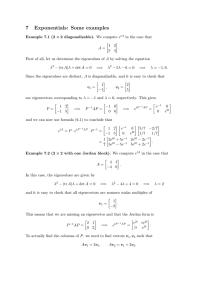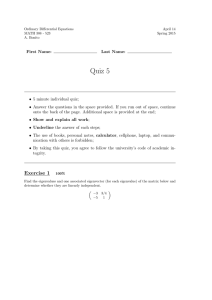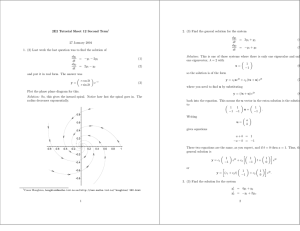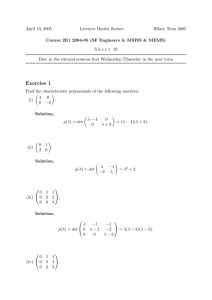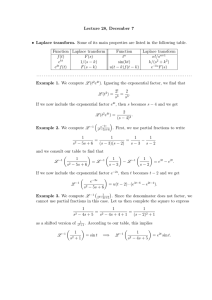ODEs, Homework #2 Solutions 1. 2.
advertisement
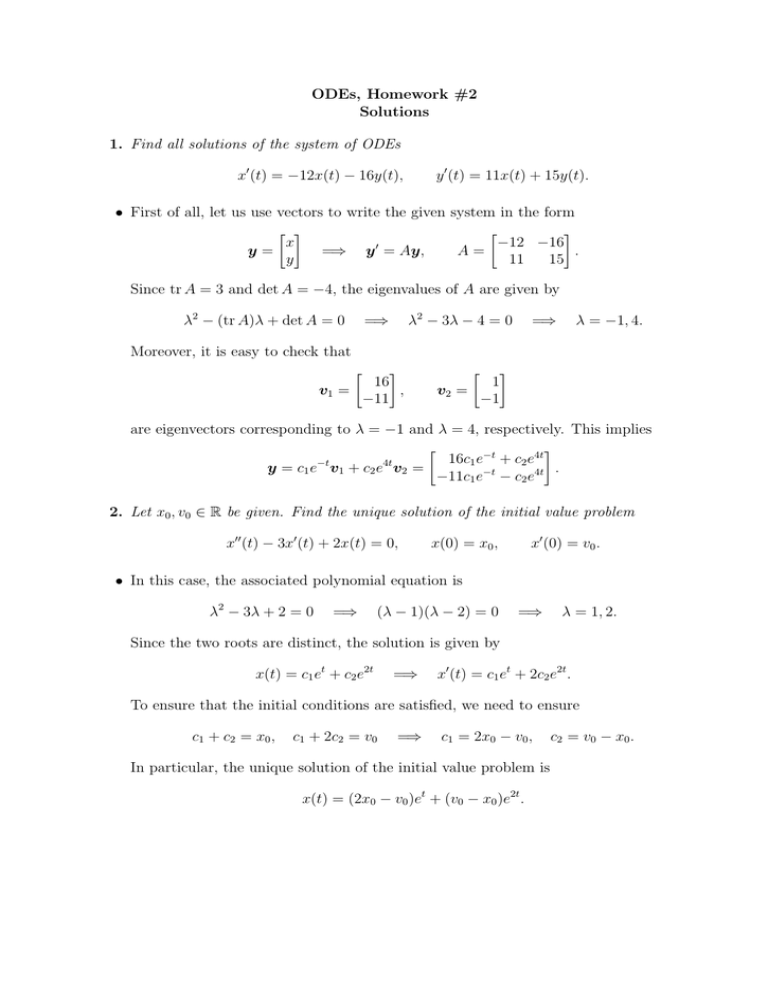
ODEs, Homework #2 Solutions 1. Find all solutions of the system of ODEs x′ (t) = −12x(t) − 16y(t), y ′ (t) = 11x(t) + 15y(t). • First of all, let us use vectors to write the given system in the form [ ] [ ] x −12 −16 ′ y= =⇒ y = Ay, A= . y 11 15 Since tr A = 3 and det A = −4, the eigenvalues of A are given by λ2 − (tr A)λ + det A = 0 λ2 − 3λ − 4 = 0 =⇒ λ = −1, 4. =⇒ Moreover, it is easy to check that [ ] 16 v1 = , −11 [ 1 v2 = −1 ] are eigenvectors corresponding to λ = −1 and λ = 4, respectively. This implies [ ] 16c1 e−t + c2 e4t −t 4t y = c1 e v1 + c2 e v2 = . −11c1 e−t − c2 e4t 2. Let x0 , v0 ∈ R be given. Find the unique solution of the initial value problem x′′ (t) − 3x′ (t) + 2x(t) = 0, x′ (0) = v0 . x(0) = x0 , • In this case, the associated polynomial equation is λ2 − 3λ + 2 = 0 =⇒ (λ − 1)(λ − 2) = 0 =⇒ λ = 1, 2. Since the two roots are distinct, the solution is given by x(t) = c1 et + c2 e2t =⇒ x′ (t) = c1 et + 2c2 e2t . To ensure that the initial conditions are satisfied, we need to ensure c1 + c2 = x0 , c1 + 2c2 = v0 =⇒ c1 = 2x0 − v0 , In particular, the unique solution of the initial value problem is x(t) = (2x0 − v0 )et + (v0 − x0 )e2t . c2 = v0 − x0 . 3. The system y′ = Ay can always be solved directly when A is upper triangular. Prove this in the case that A is 2 × 2 upper triangular with constant entries, say [ ]′ [ ][ ] x a b x = y 0 c y for some a, b, c ∈ R. Hint: solve the second equation and then solve the first. • The second equation is separable, so we can easily solve it to get ∫ ∫ dy dy = cy =⇒ = c dt =⇒ log y = ct + C0 . dt y In particular, y = C1 ect and we can now turn to the first equation, namely x′ = ax + by =⇒ x′ − ax = by = bC1 ect . This is a first-order linear equation with integrating factor ( ∫ ) µ(t) = exp −a dt = e−at . Multiplying by this factor gives a perfect derivative on the left, and we get (e−at x)′ = bC1 ect−at . In the case that a ̸= c, the last equation implies bC1 ect−at + C2 =⇒ x = C3 ect + C2 eat . c−a In the case that a = c, on the other hand, it implies e−at x = e−at x = bC1 t + C2 4. Compute the exponential etA =⇒ x = C3 teat + C2 eat . ] [ 1 2 . when A = 4 3 • In this case, tr A = 4 and det A = −5, so the eigenvalues of A are given by λ2 − (tr A)λ + det A = 0 =⇒ λ2 − 4λ − 5 = 0 =⇒ λ = −1, 5. Since the eigenvalues are distinct, A is diagonalizable, and it is easy to check that [ ] [ ] −1 1 v1 = , v2 = 1 2 are eigenvectors corresponding to λ = −1 and λ = 5, respectively. In particular, [ ] [ ] [ −t ] −1 1 −1 0 e 0 −1 tP −1 AP P = =⇒ P AP = =⇒ e = 1 2 0 5 0 e5t ] [ 5t 1 e + 2e−t e5t − e−t tA tP −1 AP −1 . =⇒ e = P · e ·P = 3 2e5t − 2e−t 2e5t + e−t 5. Find all solutions x = x(t) of the third-order equation x′′′ − x′′ − 4x′ + 4x = 0. • In this case, the characteristic equation gives λ3 − λ2 − 4λ + 4 = 0 =⇒ =⇒ =⇒ λ2 (λ − 1) − 4(λ − 1) = 0 (λ2 − 4)(λ − 1) = 0 x = c1 e−2t + c2 e2t + c3 et . ] 1 2 . when A = 2 4 [ tA 6. Compute the exponential e • In this case, tr A = 5 and det A = 0, so the eigenvalues of A are given by λ2 − (tr A)λ + det A = 0 =⇒ λ2 − 5λ = 0 =⇒ λ = 0, 5. Since the eigenvalues are distinct, A is diagonalizable, and it is easy to check that [ ] [ ] −2 1 v1 = , v2 = 1 2 are eigenvectors corresponding to λ = 0 and ] [ [ 0 −2 1 −1 =⇒ P AP = P = 0 1 2 =⇒ etA λ = 5, respectively. In particular, ] [ 0t ] e 0 0 tP −1 AP =⇒ e = 0 e5t 5 ] [ 5t 1 e + 4 2e5t − 2 tP −1 AP −1 =P ·e ·P = . 5 2e5t − 2 4e5t + 1 7. Compute the exponential etA when 1 1 1 A = 0 2 1 . 0 0 3 • The three eigenvalues are λ = 1, 2, 3 with corresponding eigenvectors 1 1 1 v1 = 0 , v2 = 1 , v3 = 1 . 0 0 1 Letting P be the matrix whose columns are these three vectors, we now get t 2t e e − et e3t − e2t −1 e2t e3t − e2t . etA = P · etP AP · P −1 = 0 0 0 e3t 8. Find all solutions of the system of ODEs x′ (t) = −3x(t) + y(t), y ′ (t) = −7x(t) + 5y(t). • First of all, let us use vectors to write the given system in the form [ ] [ ] x −3 1 ′ y= =⇒ y = Ay, A= . y −7 5 Since tr A = 2 and det A = −8, the eigenvalues of A are given by λ2 − (tr A)λ + det A = 0 =⇒ λ2 − 2λ − 8 = 0 =⇒ λ = −2, 4. Moreover, it is easy to check that [ ] 1 v1 = , 1 [ ] 1 v2 = 7 are eigenvectors corresponding to λ = −2 and λ = 4, respectively. This implies [ −2t ] c1 e + c2 e4t −2t 4t y = c1 e v 1 + c2 e v 2 = . c1 e−2t + 7c2 e4t 9. Show that every solution of x′′ (t) + 4x′ (t) + 3x(t) = 0 is such that lim x(t) = 0. t→∞ • In this case, the characteristic equation gives λ2 + 4λ + 3 = 0 =⇒ λ = −3, −1 =⇒ x(t) = c1 e−3t + c2 e−t for some constants c1 , c2 . It is thus easy to see that lim x(t) = 0, indeed. t→∞ 10. Determine the unique solution of the initial value problem 1 1 0 4 y ′ (t) = Ay(t), y(0) = 2 , A = 0 1 2 . 1 0 0 3 • In this case, λ = 1 is a double eigenvalue with corresponding eigenvectors 1 0 v1 = 0 , v2 = 1 . 0 0 There is also a simple eigenvalue, namely λ = 3, with corresponding eigenvector 2 v3 = 1 . 1 Since three linearly independent eigenvectors exist, A is diagonalizable and 1 0 2 1 P = 0 1 1 =⇒ P −1 AP = 1 0 0 1 3 t e −1 et =⇒ etP AP = 3t e t e 0 2e3t − 2et −1 et e3t − et . =⇒ etA = P · etP AP · P −1 = e3t In particular, the unique solution of the initial value problem is given by t 3t 2e − et e 0 2e3t − 2et 1 et e3t − et 2 = e3t + et . y(t) = etA y(0) = e3t 1 e3t

